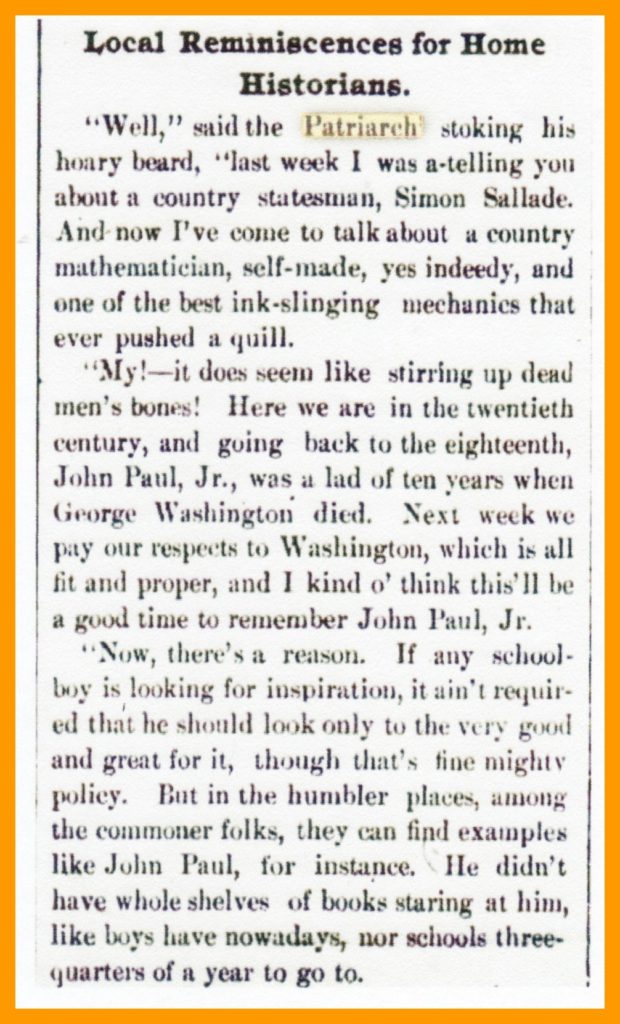Ninth in a series of nine 1904-1905 newspaper articles in which two old-timers are portrayed reminiscing about the Lykens Valley of the past. The two fictional characters, the “old railroader” and the “patriarch,” wander into the offices of the Elizabethville Echo, Elizabethville, Dauphin County, Pennsylvania at different times and tell a concise, folksy history of the valley.
_____________________________________
Local Reminiscences for Home Historians
“Well,” said the Patriarch, stoking his hoary beard, “last week I was a-telling you about a country statesman, Simon Sallade. And now I’ve come to talk about a country mathematician, self-made, yes indeedy, and one of the best ink-slinging mechanics that ever pushed a quill.
“My! – it does seem like stirring up dead men’s bones! Her we are in the twentieth century, and going back to the eighteenth, John Paul Jr., was a lad of ten years when George Washington died. Next week pay our requests to Washington, which is all fit and proper, and I kind o’ think this’ll be a good time to remember John Paul Jr.
“Now, there’s a reason. If any schoolboy is looking for inspiration, it ain’t required that he should look only to the very food and great for it, though that’s fine mighty policy. But in the humbler places, among the commoner folks, they can find examples like John Paul, for instance. He didn’t have whole shelves of books staring at him, like boys have nowadays, nor schools three-quarters of a year to go to.
“But , as the poet says: When he could not sleep for the cold, He had fire enough in his brain, – and through the long winters John was busy educating himself. When he had acquired some means, he bought the farm that used to be known as Kemerer’s where Isaiah Swab now lives. Here he kept improving himself, studied surveying without a teacher, and added to his store of knowledge every practical that he got his hands on.
“He studied algebra alone, and, – mastered it. He became a proficient civil engineer, whose services were always much in demand, not only in these parts, but away from home. He surveyed the town of Berrysburg and engineered the route of Lykens Valley Railroad. And he did it well. The story runs that he was t have an extra $10, for every curve and bend he made, and while it is open to dispute, the bends are not lacking. He was also on the engineering force that surveyed the Harrisburg, Portsmouth, and Lancaster Railroad, now a part of the Philadelphia Division of the P. R. R. When he came among the other engineers on that job mostly fellows with fine clothes and college airs, they made fun of him. John’s clothes were common corduroy; he carried his bandanna in his hat and, maybe, hadn’t seen the barber lately. When he was ready for business, he took his spectacle case out of his bonnet and hung the glasses on his nose, and, – why, they just laughed at him. But it was John Paul Jr., that did the skillful part of the surveying on that road, and NOT the fellows that jeered him.
“Moreover, John was unique and eccentric. He had a penchant for pocket knives. When a new style of whittling machinery came out, he took to it, and among his effects were found several hundred knives of all descriptions. He served at various time as Secretary of the Insurance Company, here in town, was a public conveyancer and scrivener, and best goosequill artist of the time.
“He kept a stock of hundreds of lead pencils each sharpened for some especial use; he carried a supply of steel pens that for variety was unsurpassed at the stationery stores, and goose-quills he made himself. These were almost diamond-pointed in some instances, admitting of hair lines in ornamenting certain documents. He made devices for himself that are standard tools today among all mechanical draughtsmen, and worked with such care and accuracy that several days were occupied in executing a single deed or other legal instrument.
“Yes, indeedy, and those who hold any of John Paul‘s work today know it’s something to be appreciated. Historical Societies of Schuylkill and other counties, esteem them valuable and try to secure them whenever possible. Some of the documents were executed on sheepskin parchment and bear lettering so exact as print. He was very fond of his own society and, acting on that impulse, built a house for himself, and another, – a 12-room house, for his wife. In his own castle, now occupied by the insurance company, he placed desks that fitted against the rounded front of the building, and some of the rooms are flat-irons, broad-axes, pipe-elbows and waffle-irons, in shape. Most of his work, however, was done in the long, stone-house, – the wife’s realm, where he came within a year of rounding out four score.
“He was a self-made man and a genius. He was a patriot and, as a member of Captain Dietrich’s Company, joined in the march to Baltimore, in the War of 1812. I wonder if the goodness and patriotism of George Washington did not make John Paul Jr., also a patriotic and distinguished man!”
___________________________________
From the Elizabethville Echo, 18 February 1905.
Corrections and additional information should be added as comments to this post.
